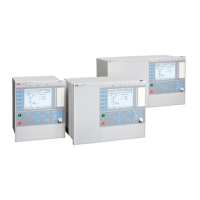the control center and also from other IEDs via bay-to-bay horizontal communication. For
LON communication an SLM card should be ordered for the IEDs.
The fibre optic LON bus is implemented using either glass core or plastic core fibre optic
cables.
Table 12: Specification of the fibre optic connectors
Glass fibre Plastic fibre
Cable connector ST-connector snap-in connector
Cable diameter 62.5/125 m 1 mm
Max. cable length 1000 m 10 m
Wavelength 820-900 nm 660 nm
Transmitted power -13 dBm (HFBR-1414) -13 dBm (HFBR-1521)
Receiver sensitivity -24 dBm (HFBR-2412) -20 dBm (HFBR-2521)
7.1.2 The LON Protocol
The LON protocol is specified in the LonTalkProtocol Specification Version 3 from
Echelon Corporation. This protocol is designed for communication in control networks
and is a peer-to-peer protocol where all the devices connected to the network can
communicate with each other directly. For more information of the bay-to-bay
communication, refer to the section Multiple command function.
7.1.3 Hardware and software modules
The hardware needed for applying LON communication depends on the application, but
one very central unit needed is the LON Star Coupler and optical fibres connecting the star
coupler to the IEDs. To interface the IEDs from the MicroSCADA with Classic Monitor,
application library LIB520 is required.
The HV Control 670 software module is included in the LIB520 high-voltage process
package, which is a part of the Application Software Library in MicroSCADA
applications.
The HV Control 670 software module is used for control functions in the IEDs. The
module contains a process picture, dialogues and a tool to generate a process database for
the control application in MicroSCADA.
When using MicroSCADA Monitor Pro instead of the Classic Monitor, SA LIB is used
together with 670 series Object Type files.
Section 7 1MRK 504 165-UUS -
Establishing connection and verifying the LON communication
66 Transformer protection RET670 2.2 ANSI
Commissioning manual

